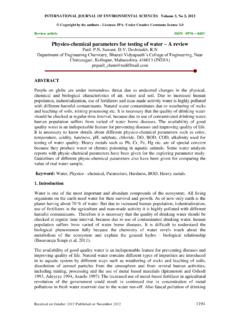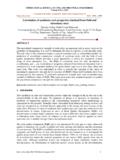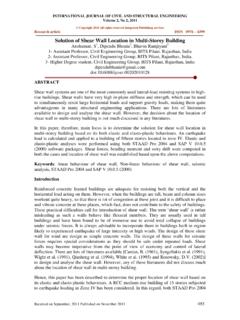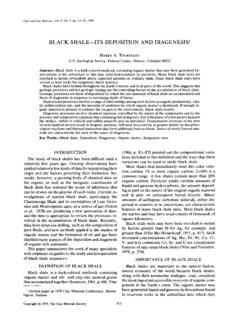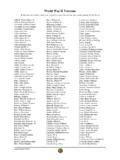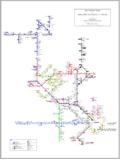Transcription of Reliability of using standard penetration test (SPT) …
1 INTERNATIONAL JOURNAL OF CIVIL AND STRUCTURAL ENGINEERING Volume 3, No 3, 2013 Copyright by the authors - Licensee IPA- Under Creative Commons license Research article ISSN 0976 4399 Received on January 2013 Published on March 2013 545 Reliability of using standard penetration test (SPT) in predicting properties of silty clay with sand soil Mostafa Abdou Abdel Naiem Mahmoud Associate Professor, Civil Engineering Department, Assiut University, Assiut 71516, Egypt Civil Eng .Department, Faculty of Engineering, Aljouf University, KSA ABSTRACT The properties of soil play an important role in many practices for geotechnical engineering. To determine the real values of these properties special techniques should be followed such as undisturbed samples and initial overburden pressures should be taken into consideration.
2 Actually, it is difficult to obtain 100 % undisturbed samples due to handling, transportation, release of overburden pressure and poor laboratory conditions. So, prediction of some properties such as shear strength parameters (c & ) for hard and dry silty clay with sand soil with the help of standard penetration test (SPT) provides a good opportunity to obtain these parameters without using of more laboratory tests . standard penetration tests (SPT), rough measure the strength of soil. The great merit of this test and the main reason for its widespread use is that it is simple and inexpensive. The shear strength parameters which can be inferred are approximate, but may give a useful guide in ground conditions where it may not be possible to obtain borehole samples of adequate quality like clay containing sand or gravel. This study was undertaken in order to study the Reliability of using standard penetration test (SPT) in predicting some properties, (such as Atterberg limits LL, PL, PI, and shear strength parameters (c & )), of silty clay with sand soil.
3 Many samples from this soil have been investigated for this purpose. The results of the research indicated that the shear strength of soil affects SPT number. Empirical equations to identify the shear strength parameters of silty clay with sand soil using corrected SPT number (N") have been proposed. Keyword: Silty clay with sand, (c & ), LL, PL, PI, SPT, correction coefficient, field tests . 1. Introduction Numerous methods have been developed for determination the soil properties. These methods include the field and laboratory tests . Also, to determine the real values of these properties, special techniques should be followed such as undisturbed samples and initial overburden pressures should be taken into consideration. On the other hand, field test such as SPT does not depend on undisturbed sample because it is carried out in original field soil. Most problems in soils and construction involve either the strength of the in-situ soil or the compressibility of the soil mass.
4 People tend to have a negative opinion of clay soils. These soils may not drain quickly after heavy rain and often harden when dry. Most soils contain a mixture of clay , organic matter, sand and silt. If a soil contains at least 40 percent clay , then we classify it as a " clay soil" (Tuker, 1999). clay is made up of tiny particles less than mm in diameter. By comparison, silt particles range from to mm in size and sand particles from to mm. For this reason, clay soils are considered to be fine textured; silt, medium textured; and sand coarse textured. clay acts as a binding agent between soil particles. It gives soil elasticity and provides cohesion of soil particles. On the other hand, sand provides friction of soil particles. Properties of silty clay with sand soil are significantly Reliability of using standard penetration test (SPT) in predicting properties of silty clay with sand soil Mostafa Abdou Abdel Naiem Mahmoud International Journal of Civil and Structural Engineering 546 Volume 3 Issue 3 2013 associated with stiffness of this soil and give an indication of shear strength of soil.
5 These properties plays an important role in many practices for geotechnical engineering, such as soil description or classification of soil, prediction of behavior of soil if it will be subjected to extensive settlement or swelling. The real value of these properties such as angle of internal friction ( ) and cohesion (c) require a special care and laboratory technique. So, prediction of soil properties with the help of field tests such as standard penetration tests (SPT) provides a good opportunity to obtain this parameter without using of more laboratory tests . standard penetration tests (SPT), rough measure the strength of soil. It is currently the most popular and economical means of obtaining subsurface information. The SPT has been extended to other areas of soil mechanics and foundations, and it has become a fundamental parameter in geotechnical engineering. The great merit of the test and the main reason for its widespread use is that it is simple and inexpensive.
6 In conditions where the quality of the undisturbed sample is suspect, silty clay with sand soil, it is often advantageous to alternate the sampling with standard penetration tests to check the strength. standard penetration test (SPT) is one of the field tests of soil. It primary gives idea about shear strength of soil which it can be expressed in terms of shear strength parameters (c & ). Most laboratory tests must be performed on molded samples of soils. These tests are laborious and time consuming; but sometimes the results are not accurate due to the poor laboratory conditions (Venkatasubramanian and Dhinakaran, 2011). An aggregate that contains sufficient fines to fill all voids between aggregate grains will still gain its strength from grain-to-grain contact but has increased shear resistance (Siswosoebrotho et al., 2005). Plasticity index (PI) and liquid limit (LL) can be used to determine the swelling characteristics of expansive clay in general (Subjianto et al.)
7 , 2011). (Garham, 2012) indicates that it is a poor ability to get similar results when testing different portions of the same samples, but the result differences should be below the upper control limit. Sometimes, Strength values determined from laboratory testing of intact soil cores are recognized as not being directly applicable to the in-situ soil mass because of the scale effect. The standard penetration test (SPT) is very widely used for subsurface investigation in many parts of the world. It measures the resistance of a hollow core being hammered with a weight. The hollow core receives a soil sample during the process which is logged to soil identification purposes. The relative density can be estimated from the number of blows used to drive the SPT a total of distance of 450mm with the total blows for the last 300mm being the SPT Nf -value (Silva, 2010). To construct a structure, Nf value (SPT value) is an important parameter to understand the soil condition at different depths.
8 After investigating Nf value of different depths, foundation depth can be selected according to load of the structure. Then determine the corrected N" value at the required depth. Angle of internal friction is determined from corrected SPT N"-value. After that, determine bearing capacity factors to calculate the bearing capacity of the soil. From this bearing capacity of soil foundation can be designed (Humyral et al. 2012). When the SPT hammer impacts the drill rod, it creates a compression stress wave that travels dawn the rod and at the same time propagates in the hammer (Abou-mater et al., 1997). Terzaghi, 1940 realized that the penetration resistance of the split-spoon sampler could provide useful in-site test data that might be correlated with the consistency and density of the soils encountered. He discussed with Harry Mohr and developed correlations between the number of blows, N, and a number of salient properties of soils, including the relative density of sands, consistency and unconfined compressive strength of clays, and allowable bearing pressure on sands and clays.
9 The first published SPT correlations appeared in Terzaghi and Reliability of using standard penetration test (SPT) in predicting properties of silty clay with sand soil Mostafa Abdou Abdel Naiem Mahmoud International Journal of Civil and Structural Engineering 547 Volume 3 Issue 3 2013 Peck, 1948. These were soon followed by correlations relating SPT blow counts to consistency for silts and clays and relative density for sands in (Peck et al., 1953). A less recognized problem is the influence of strata thickness and changes in stiffness, sketched in Figure 1. As the sample barrel approaches an appreciably stiffer horizon, the penetration resistance will increase, even though the sampled material remains more or less constant throughout the softer horizon.
10 This can lead to overestimates of strength, density, and compressibility based solely on blow-count values. A big disadvantage of the SPT procedure is that it reports the average blows per foot during any given sample round, so the measurement would only be valid for horizons .12 in. ( cm) thick, plus the influence area beneath the sampler shoe sketched in Figure 1. This is the zone of influence in front of the sampler shoe. This influence zone usually equal to four to seven times the sample barrel diameter. Overall, the SPT procedure tends to average the penetration resistance of the materials sampled, and the material effects of low strength horizons less than 20 26 in. Soil behavior is greatly influenced by sampling disturbance. Nevertheless, disturbed samples may be adequate for indices tests such as Atterberg limits and grain size distribution, but slightly more suspect density and water content because of densification (Rogers, 2006).

